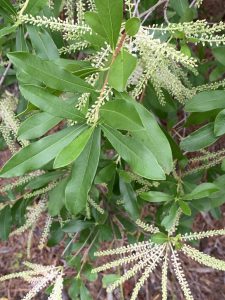Today, it seems more and more of a struggle to keep hives healthy. Diseases, parasites, exposure to pesticides, and even bear encounters are just some of the issues that beekeepers seem to constantly battle. You can add undesirable plants to that list, as well. Yes, even placing your hives close to certain plants can cause major issues. There are two undesirable plants in the Panhandle to scout for when moving hives, regarding the vicinity of these plants and the home range of your honeybee operation.
Summer titi (Cyrilla racemiflora), also known as white or swamp titi, is spread widely throughout North Florida. This is typically a shrub in stature, but under the right growing conditions can easily develop into a subtree. It is found in low wetland areas, but can adapt to dry soils. The bloom can be described as having showy, white clusters, that elongate in different directions. Although found in the wild, this plant is a favorite ornamental for the home landscape, as the leaves turns to an orange-red color in the fall. Bloom window is from May through July. It usually produces little nectar, but in years with significant winter rainfall, nectar can be in a significant amount. There lies the problem. The pollen is responsible for a condition known as “purple brood,” which kills the brood, turning it a dark purple color. Purple brood is disastrous to a colony, and specifically harmful to immature honeybees. Historically, the far eastern Panhandle counties (Jefferson & Taylor), are where summer titi abounds. Beekeepers in this area are well aware of summer titi and routinely move their bees away during the blooming season. This plant should not be confused with spring titi (Cliftonia monophyla), also known as buckwheat tree, which is found in the same growing areas in the wild, but blooms from February through March. Spring titi is a safe for honeybees and an excellent honey plant.
Another plant species of interest to scout for is Carolina or Yellow Jessamine (Gelsemium sempervirens). This is an evergreen, woody vine that can be found in areas throughout North Florida, especially in open woodlands and roadsides. The trumpet like blooms are very fragrant. Also, this is a landscape favorite, as it is used for arbors, trellises and pergolas. The bloom window is earlier in the year, through the months of February and March. Pollen from Yellow Jessamine contains alkaloids, that are toxic to honeybees. This factor isn’t as lethal as purple brood, but the toxic alkaloids will reduce the overall population strength of the colony.
Along with scouting for any undesirable plants, The Florida Beekeeping Calendar for July recommends monitoring for Varroa mites. Consider treating when Varroa levels reach 3% (3 mites per 100 bees as determined by an alcohol wash or a sugar shake). Treatment options include: Apiguard, Apistan, Apivar, Hopguard, and Mite Away (always follow label instructions).
Following these tips will help ensure your hive is healthy and productive. Contact your local county extension office for more information.
–
For information on how to monitor for Varroa mites, read:
Tools for Varroa Management, and Sampling Methods video.
Florida Beekeeping Calendar
–
The main flow is prime at this time of year for many types of honey. It’s a good time to remove and process you product.
For more information, see Bottling, Labeling, and Selling Honey in Florida.
–
For more supporting information for this article, please see the UF/IFAS blog posts on Summer Titi and Yellow Jessamine.
- Challenges Using Oxalic Acid Against Summer Varroa Mite Infestations for Panhandle Beekeepers - July 11, 2025
- Managing Pine Stands for Straw Production - January 10, 2025
- Disaster Preparedness for the Ranch - June 21, 2024


